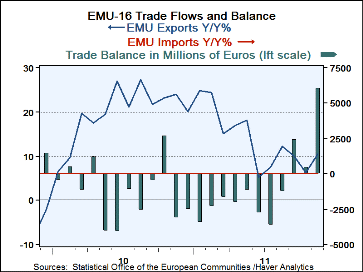 Global| Jan 13 2012
Global| Jan 13 2012Euro-Area Surplus Jumps as Exports Gain Strongly and Imports Flat-Line
Summary
EMU seems to have posted a one-off result. Imports continue to erode in-line with other reports on economic weakness in the Zone but exports have sprung to life like a thought-to-be-dead vampire springing up from the grave on a foggy [...]
 EMU seems to have posted a one-off result. Imports continue to erode in-line with other reports on economic weakness
in the Zone but exports have sprung to life like a thought-to-be-dead vampire springing up from the grave on a foggy
night. Gotcha! But this is unlikely to be a reversal of trend. Exports and imports have been in a slowdown mode for some
time. Imports actually did strengthen as well going from -0.7% in October to flat in November
EMU seems to have posted a one-off result. Imports continue to erode in-line with other reports on economic weakness
in the Zone but exports have sprung to life like a thought-to-be-dead vampire springing up from the grave on a foggy
night. Gotcha! But this is unlikely to be a reversal of trend. Exports and imports have been in a slowdown mode for some
time. Imports actually did strengthen as well going from -0.7% in October to flat in November
Import growth has been weaker than export growth for some time and this configuration has resulted in a widening of the EMU trade surplus, a surplus that jumped this month to €6.1bln in November from €0.5bln in October. The surplus was the largest since July of 2004 and could go a long way toward boosting what has been promising to be weak growth in EMU in 2011-Q4.
Still, the bottom line is that European exports simply have no strong demand to sell into in order to main their pace. The global economy is slowing so the month’s result really hangs its hat on the notion of quixotic forces rather than unexpected surging fundamentals. Indeed, it’s probably more likely that a Zombie will jump out of his grave undead than that EMU exports will maintain their strength.
Markets will puzzle over this number and it is a good number though surprising and beyond belief. The next question is about December and if December will prove to be an unwind of this spurt that brings the average back to earth as timing asymmetries settle back to normal or if some inexplicable bulge in activity will remain. But not get up false hopes on this report.
| Euro-Area Trade trends for goods | ||||||
|---|---|---|---|---|---|---|
| M/M% | % SAAR | |||||
| Nov-11 | Oct-11 | Sep-11 | 3M | 6M | 12M | |
| Balance* | € 6,100 | € 500 | € 2,500 | € 3,033 | € 267 | € (932) |
| Exports | ||||||
| All Exp | 3.9% | -2.0% | -1.2% | 2.6% | 4.1% | 10.4% |
| Food and Drinks | - | -2.2% | 0.3% | -3.7% | 4.4% | 11.7% |
| Raw materials | - | -3.6% | 1.1% | 24.4% | 14.2% | 12.3% |
| MFG | - | -2.3% | -2.3% | -12.0% | 0.5% | 4.3% |
| Imports | ||||||
| All IMP | 0.0% | -0.7% | -3.7% | -16.3% | -5.6% | 3.4% |
| Food and Drinks | - | -2.5% | -0.9% | -2.3% | -0.8% | 8.1% |
| Raw materials | - | -4.8% | -0.4% | -29.0% | -15.2% | 7.2% |
| MFG | - | -1.8% | -5.4% | -22.6% | -8.0% | 0.4% |
| *Eur mlns; mo or period average; Gray shaded areas lag one month | ||||||
Robert Brusca
AuthorMore in Author Profile »Robert A. Brusca is Chief Economist of Fact and Opinion Economics, a consulting firm he founded in Manhattan. He has been an economist on Wall Street for over 25 years. He has visited central banking and large institutional clients in over 30 countries in his career as an economist. Mr. Brusca was a Divisional Research Chief at the Federal Reserve Bank of NY (Chief of the International Financial markets Division), a Fed Watcher at Irving Trust and Chief Economist at Nikko Securities International. He is widely quoted and appears in various media. Mr. Brusca holds an MA and Ph.D. in economics from Michigan State University and a BA in Economics from the University of Michigan. His research pursues his strong interests in non aligned policy economics as well as international economics. FAO Economics’ research targets investors to assist them in making better investment decisions in stocks, bonds and in a variety of international assets. The company does not manage money and has no conflicts in giving economic advice.






